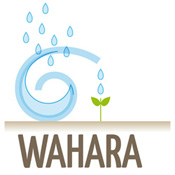Video
- Details
- Created on Thursday, 21 June 2012 07:59
- Written by Erik van den Elsen
Water and Water Harvesting related Videos
This page contains videos about examples in water harvesting and other related topics for saving water. Click the links below for jumping to the corresponding video windows.
An interesting resource of related video's can be found HERE. This is a link to the IFAD video website, that displays a number of instructional videos on sustainable land management.
Land, Water and Livelihoods: The Watershed Movement in Tigray
WAHARA Small Videos English
- Micro Basins
- Stone Bunds
- Spring development in Tigray
- Spate Irrigation in Northern Ethiopia
- Micro-Dams
- Gully Treatment in Tigray
- Hand-dug Wells
- Area Closure
- Night Storage of Irrigtion Water
- Diversion Weirs
WAHARA Small Videos French
- Micro Basins
- Stone Bunds
- Spring development in Tigray
- Spate Irrigation in Northern Ethiopia
- Micro-Dams
- Gully Treatment in Tigray
- Hand-dug Wells
- Area Closure
- Night Storage of Irrigtion Water
- Diversion Weirs
Presentations recorded in 2012 at Wageningen meeting
- Mike Kirkby: Continental-scale Quick-Scan Tool Development
- WOCAT Technologies and Approaches, Ethiopia
- Technologies selected and their justification, Zambia
- Existing and potential water harvesting Tunisia (presentation)
Various webinars
Miscellaneous
Water Harvesting examples
|
Example of water harvesting using Stone Lines |
Example of water harvesting using Fanya Juu Terraces |
|
|
|
|
Stone lines or ("bunds") slow down runoff and increase water infiltration to improve production in semi-arid areas. At the same time, sediment is captured behind these semi-permeable barriers. Stone lines were originally a traditional technique in the Sahel, but have been improved by careful construction, and through aligning them onto the contours of the land. A perennial grass (Andropogon guyanus) is sometimes planted to supplement the lines where stone is scarce. Stone lines are suited to low slopes, high runoff and hand labour. This technique is readily adopted by resource-poor farmers and can lead to a harvest even in years with low and erratic rainfall. Wide and deep planting pits (called 'zai' in Burkina Faso; 'tassa' in Niger) are often used in combination, acting as microcatchments within the field. [Source: www.iied.org] |
Fanya juu ("throw the soil up" in Kiswahili) terraces are the most popular and successful cross-slop barrier measures used in Kenya's small scale farming sector. Contour earth bunds are constructed by throwing soil upwards from trenches immediately below them. This design leads to the gradual formation of terraces with a level or slightly forward sloping bed.
This is a very versatile technology - ideally suited to smallholder farms, especially in sub-humid areas where the land is sloping and erosion a threat. Fodder grasses may be planted on the bunds and fed to livestock. In the dry areas, water harvesting from roads into the trenches allows production of bananas and fruits. This is a proven and effective adaptation technology in the highlands of East Africa and beyond. |
|
Zero impact area's |
Diversion Weirs |
|
Zero-impact area's targets recovery of soil coverage in the Tigray area. Fences disable livestock and humans to enter protected zones, so that vegetative species find time to regenerate. Hand-in-hand with other soil and water conservation measures, this method is baring fruit, as soil coverage and species diversity increased. The video highlights the arrival of new flowering plants, which stood at the basis of the revival of the honey industry. Honey is now the 4th biggest export of Ethiopia.
Category: Soil Conservation
Tags: Area Closure, Zero impact, Grazing, Livestock, Honey, Ethiopia, TWCprod
|
This video demonstrates how a diversion weir is used to divert waters from a river to agricultural fields at a higher level. These images are from Tigray, Ethiopia.
Category: Agriculture
|
| Spring development | Wells |
|
How a community in Tigray, Ethiopia is maximizing the benefits of a local spring by constructing a diversion checkdam and irrigation canals.
Category: Groundwater
Tags: spring, development, ethiopia, tigray, diversion, checkdam, canal, agriculture, WAHARA, TWCprod
|
In Kifle Awlaelo, Tigray province, Northern Ethiopia 26 families are digging and shaping a new well to serve their community. Following the soil and water conservation measures taken in Tigray over the past 20 years, groundwater tables have risen making it easier for communities to access groundwater resources.
Category: Groundwater
Tags: Groundwater, Hand-dug wells, Tigray, Kifle Awlaelo, wahara, TWCprod
|
